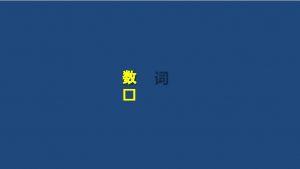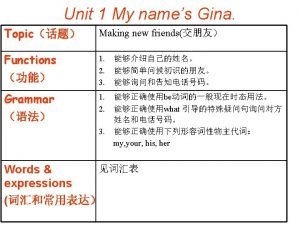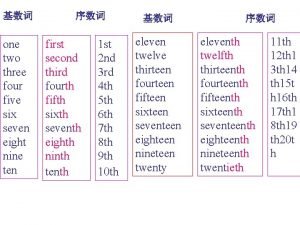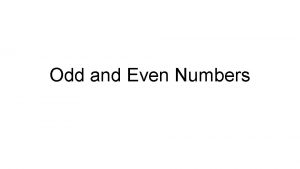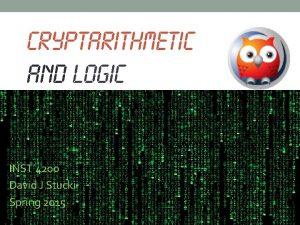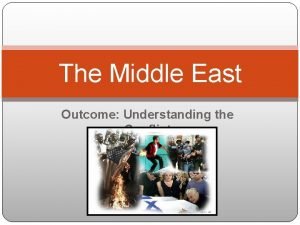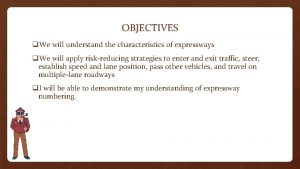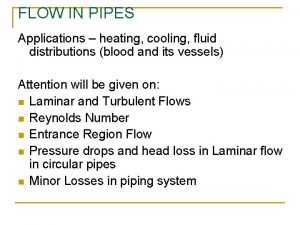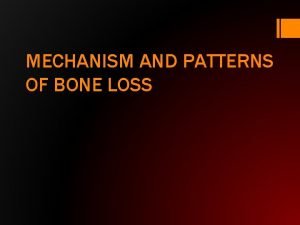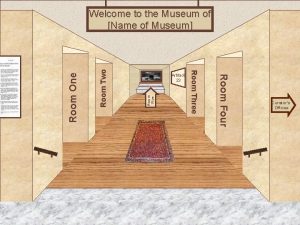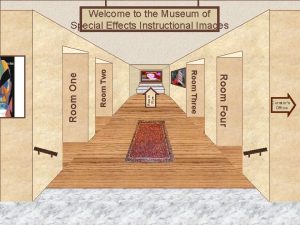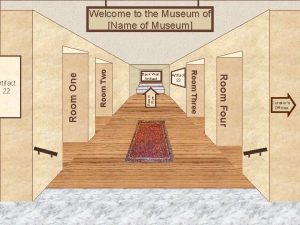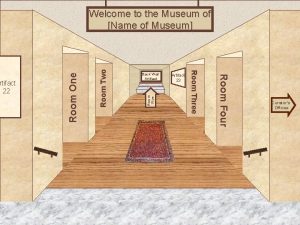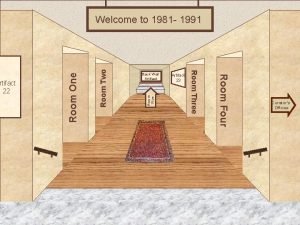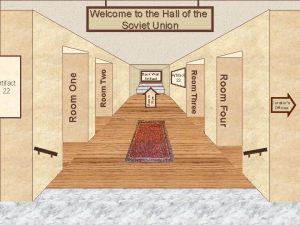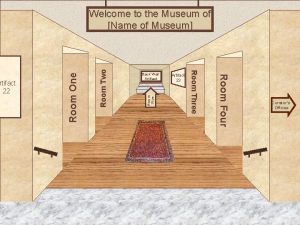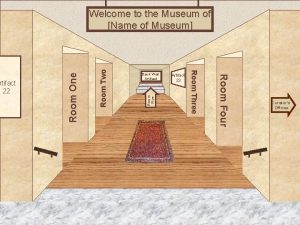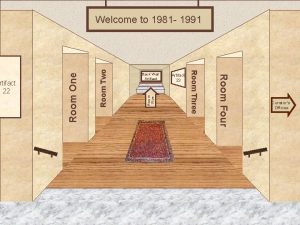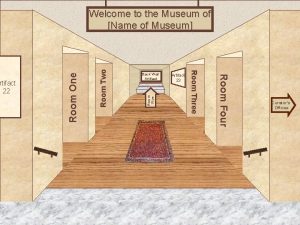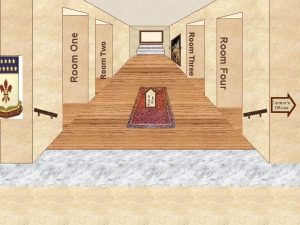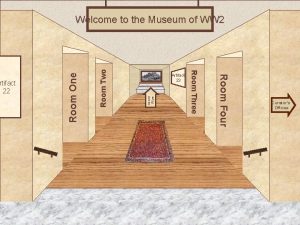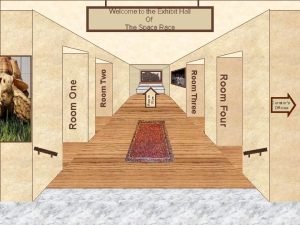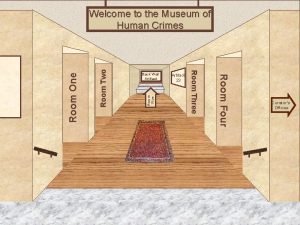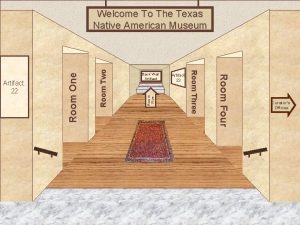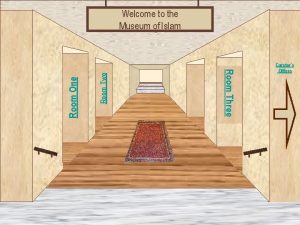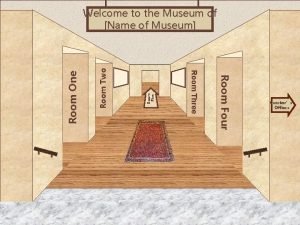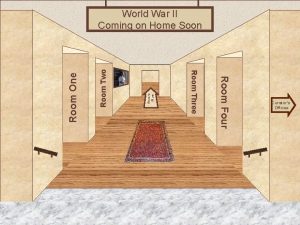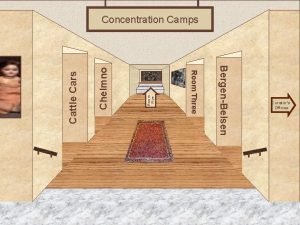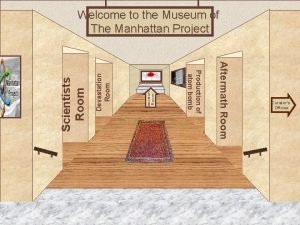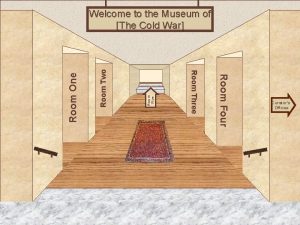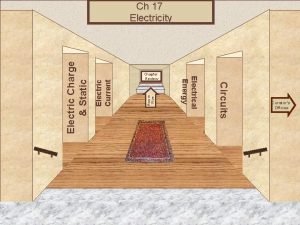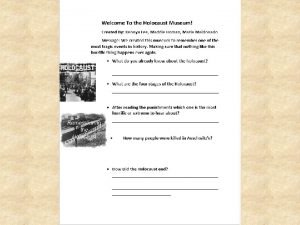Room Two Room Five Museum Entrance Room Four


![[Room 1] Room 1 Return to Entry [Room 1] Room 1 Return to Entry](https://slidetodoc.com/presentation_image_h2/549192abcebdfab0c5cd027d13ee7820/image-3.jpg)
![[Room 2] Room 2 Return to Entry [Room 2] Room 2 Return to Entry](https://slidetodoc.com/presentation_image_h2/549192abcebdfab0c5cd027d13ee7820/image-4.jpg)
![[Room 3] Room 3 Return to Entry [Room 3] Room 3 Return to Entry](https://slidetodoc.com/presentation_image_h2/549192abcebdfab0c5cd027d13ee7820/image-5.jpg)
![[Room 4] Room 4 Return to Entry [Room 4] Room 4 Return to Entry](https://slidetodoc.com/presentation_image_h2/549192abcebdfab0c5cd027d13ee7820/image-6.jpg)
![[Room 5] Room 5 Return to Entry [Room 5] Room 5 Return to Entry](https://slidetodoc.com/presentation_image_h2/549192abcebdfab0c5cd027d13ee7820/image-7.jpg)


















- Slides: 25

Room Two Room Five Museum Entrance Room Four Room Three Room One Proxy Wars and Conflicts Curator’s Offices

Lauryn Rutherford Curator’s Office I specialize in the Proxy Wars and conflicts, and I am quite intelligent. Contact me at [coldwarfrreak 3@gmail. com] Return to Entry Note: Virtual museums were first introduced by educators at Keith Valley Middle School in Horsham, Pennsylvania. This template was designed by Dr. Christy Keeler. View the Educational Virtual Museums website for more information on this instructional technique.
![Room 1 Room 1 Return to Entry [Room 1] Room 1 Return to Entry](https://slidetodoc.com/presentation_image_h2/549192abcebdfab0c5cd027d13ee7820/image-3.jpg)
[Room 1] Room 1 Return to Entry
![Room 2 Room 2 Return to Entry [Room 2] Room 2 Return to Entry](https://slidetodoc.com/presentation_image_h2/549192abcebdfab0c5cd027d13ee7820/image-4.jpg)
[Room 2] Room 2 Return to Entry
![Room 3 Room 3 Return to Entry [Room 3] Room 3 Return to Entry](https://slidetodoc.com/presentation_image_h2/549192abcebdfab0c5cd027d13ee7820/image-5.jpg)
[Room 3] Room 3 Return to Entry
![Room 4 Room 4 Return to Entry [Room 4] Room 4 Return to Entry](https://slidetodoc.com/presentation_image_h2/549192abcebdfab0c5cd027d13ee7820/image-6.jpg)
[Room 4] Room 4 Return to Entry
![Room 5 Room 5 Return to Entry [Room 5] Room 5 Return to Entry](https://slidetodoc.com/presentation_image_h2/549192abcebdfab0c5cd027d13ee7820/image-7.jpg)
[Room 5] Room 5 Return to Entry

Artifact 1 The Berlin Blockade 1948 -1949 Berlin Blockade was the first serious crisis of the Cold War. The United States and the Soviet Union had clashed over Germany, and when the allies decided to withdraw their forces and allow their occupation zones to form one nation, the Soviets responded by holding West Berlin hostage. Soon Berlin was split into four zones. The Soviet Union cut off highway, water, and rail traffic into West Berlin and the city faced starvation. Instead of giving up the Allies soon started the Berlin Airlift to deliver supplies into West Berlin. The blockade ended up being ineffective to the Soviets. It triggered fear in the west, accelerated Allies plans to set up the state, and hastened the creation of NATO. In 1949, it was clear that Source Citation: Stalin PARRISH, "Berlin the objectives had. THOMAS. in mind were not Blockade. " Encyclopedia of Russian History. Ed. lift. James going to be met and had no choice but to R. Vol. 1. New York: Macmillan Reference USA, the. Millar. blockade. 2004. 142 -143. World History in Context. Web. 22 Apr. 2014. Image found at: Berlin Blockade. Digital image. The Berlin Airlift Crisis. N. p. , n. d. Web. 22 Apr. 2014 Return to Exhibit

Artifact 2 The Berlin Airlift 1948 -1949 When the Berlin Blockade reached the point where Berlin’s people were on the brink of starvation the Allies decided to deliver necessary supplies by air, this was known as the Berlin Airlift. From June 1948 to May 1949, Allied planes took off and landed every three minutes in West Berlin. The Berlin Airlift lasted for about a year and delivered 2. 3 million tons of cargo during its time. It prevented the people from dying from starvation, if only for a Source Citation: LERNER, ADRIENNE WILMOTH. little while. "Berlin Airlift. " Encyclopedia of Espionage, Intelligence and Security. Ed. K. Lee Lerner and Brenda Wilmoth Lerner. Vol. 1. Detroit: Gale, 2004. 99 -101. World History in Context. Web. 22 Apr. 2014 Image found at: "Children in West Berlin waiting for a U. S. supply plane to land during the Berlin airlift of. . . " History in Dispute. Ed. Benjamin Frankel. Vol. 1: The Cold War: First Series. Detroit: St. James Press, 2000. World History in Context. Web. 22 Apr. 2014 Return to Exhibit

Artifact 3 Greek Civil War The Greek civil war was two-stage encounter in which Greek communists unsuccessfully tried to gain control of Greece. With this political uncertainty in Greece, General Ioannis Metaxas took power with a fascist-style dictatorship. Once Metaxas died in 1941, Greece was left helpless and the Communist Party took control and created the National Liberation Front, also called the EAM. Another group was against the EAM, called the National Republican Greek League (EDES). In 1947, the United States agreed to help so President Truman issued the Truman Doctrine to help Greece fight the Communists. When the communists decided to support Stalin instead of Image found at: Yugoslavia, they were soon defeated in 1949. The civil war left Greece in ruins. However, in the Greek Civil War 1946 -1949. Digital image. The 1950’s, Greece went through a growth of Greek Civil War. N. p. , n. d. Web. 22 Apr. 2014 development. From 1960 to 1974, Greece was Return to ruled by Georgios Papandreou. Finally 1974, Source Citation: "Greece. " Europe Since 1914: in. Encyclopedia of Exhibit the Age ofwas Warrestored and Reconstruction. Ed. Johnby Merriman and Jay Greece as a democracy Winter. Vol. 3. Detroit: Charles Scribner's Sons, 2006. 1266 -1271. Konstantinos Karamanlis. World History in Context. Web. 22 Apr. 2014.

Artifact 4 Iron Curtain Popularized in a speech by Winston Churchill (1874– 1965), The term Iron Curtain refers to the reduced contact and restricted travel executed by the Soviet Union between the communist countries of Eastern Europe and the capitalist-democratic nations of Western Europe during the Cold War (1945– 1991). A truly effective physical barrier between the two Germanys and Czechoslovakia and between Austria and Hungary did not exist until the early 1960 s. For Western politicians and commentators, the Iron Curtain dramatized the isolation of the police states forced upon the Eastern Source Citation: "Iron Curtain. " Europe Since 1914: Encyclopedia of the Age of Warby andthe Reconstruction. Ed. John Merriman and Europeans Soviet Union Jay Winter. Vol. 3. Detroit: Charles Scribner's Sons, 2006. 14551456. World History in Context. Web. 22 Apr. 2014. Image found at: The Iron Curtain. Digital image. Iron Curtain. N. p. , n. d. Web Return to Exhibit

Artifact 5 Korean War 1950 -1953 The Korean War began just as a war between Communist and non-Communist forces in Korea from June 25, 1950, to July 27, 1953. At the end of World War II, Korea was divided at the 38 th parallel into Soviet (North Korean) and U. S. (South Korean) zones. In 1948 two different governments were established: The Republic of Korea in the South and the People's Democratic Republic of Korea in the North. Relations became increasingly tense, and on June 25, 1950, North Korea invaded South Korea. The United Nations ended up helping the South. In the first few weeks the North ended up advancing rapidly, but a counteroffensive soon began on September 15 th by the South and pushed them back to the Chinese border. The Chinese felt threatened and sent troops to aid North Korea. When the Chinese captured the capital, Seoul, Doulas Mac. Arthur wanted to launch a nuclear attack on China but President Truman refused. In July, 1953 the UN forces and North Korea signed a cease-fire agreement. After the war, Korea remained divided. A demilitarized zone, separated the War--1945 -1991. two countries. Gale, Source Citation: "Korean War. " The Cold 1992. World History in Context. Web. 22 Apr. 2014. Image found at: “Korean War. ” 2014. The History Channel website. Apr 22 2014, 11: 23 http: //www. history. com/photos/korean-war. Return to Exhibit

Artifact 6 Hungarian Revolution 1956 On October 23 rd, 1956, students of Budapest took to the streets and issued their thoughts on what should be their rights, which included personal freedom, more food, the removal of the secret police, the removal of Russian control etc. Soon Imre Nagy was appointed prime minister, and Janos Kadar as foreign minister. On October 31 st, he announced that Hungary should withdraw itself form the Warsaw Pact. This made the Soviets mad and they went around Budapest to “restore order” by killing, even the wounded. Nagy was then tried and executed and Kadar was in charge. Soviet rule was now re-established. Source Citation: GRANVILLE, JOHANNA. "Hungarian Revolution. " Encyclopedia of Russian History. Ed. James R. Millar. Vol. 2. New York: Macmillan Reference USA, 2004. 643 -644. World History in Context. Web. 22 Apr. 2014 Image found at: GRANVILLE, JOHANNA. "Hungarian Revolution. " Encyclopedia of Russian History. Ed. James R. Millar. Vol. 2. New York: Macmillan Reference USA, 2004. 643644. World History in Context. Web. 22 Apr. 2014. Return to Exhibit

Artifact 7 Suez Crisis 1956 The Suez Crisis of October 1956, was a coordinated attack by British, French, and Israeli forces on Egyptian locations in the Sinai Peninsula and along the Suez Canal. It was a crucial moment for interstate relations within the region, and also for interactions between the superpowers within the larger part of the cold war. Triggered by numerous factors and settled by an uneasy cease-fire, the Suez Crisis left Image found at: a great deal of “unfinished business” "Britains Empire Ken sails into Port Said, Egypt, on the table between Israel and the carrying reinforcements during the Suez Crisis of. . . " Cold War Reference Library. Ed. Richard C. Arab States. It also saw the first full Hanes, Sharon M. Hanes, and Lawrence W. Baker. engagement of the. Crisis. " United States into Source citation: "Suez International Encyclopedia of Vol. 2: Almanac Volume 2. Detroit: UXL, 2004. World History in Context. Web. 22 Apr. 2014. Return to the Sciences. Ed. William A. Darity, Jr. 2 nd ed. Vol. 8. the. Social region. Detroit: Macmillan Reference USA, 2008. 213 -214. World History in Context. Web. 22 Apr. 2014 Exhibit

Artifact 8 Vietnam War 1957– 1975 In the early 1900 s France controlled most of Southeast Asia. Nationalist independence movements had soon started. During the 1930 s, a man named Ho Chi Minh, started a communist party and led revolts against the French. The French started killing Vietnamese protesters and sentenced Minh to death but he fled to exile instead, and ended coming back in 1941. In 1957, Vietnamese Nationalists and Communists joined to fight the French armies. The Vietminh used hit-and-run tactics to confine the French to the cities. In 1954, the French suffered a major military defeat at Dien Bien Phu and they surrendered to Ho. The U. S soon saw this as a threat and Dwight D. Eisenhower soon called it the Domino Theory. After France’s defeat, an international peace conference met in Geneva to discuss the future of Indochina. Vietnam was divided at 17° north latitude. North was Ho Chi Minh’s Communist forces and South was the United States and France under the anti-communist leader, Ngo Dinh Diem. U. S. Troops Enter the Fight In August 1964. Unable to win a decisive victory on the ground, the United States turned to air power. During the late 1960 s, the war grew increasingly unpopular in the United States. Nixon had a plan called Vietnamization. It allowed for U. S. troops to Source "Vietnam War. " gradually. Citation: pull out. Two years later, the. International North Vietnamese Encyclopedia of the and Social overran South Vietnam the Sciences. war ended. Ed. William A. Darity, Jr. 2 nd ed. Vol. 8. Detroit: Macmillan Reference USA, 2008. 612 -617. World History in Context. Web. 22 Apr. 2014 Image found at: Vietnam Flag. Digital image. Crossfire Wiki. N. p. , n. d. Web: crossfirewikia. com Return to Exhibit

Artifact 9 The Cuban Revolution 1953 -1959 In the 1950 s, Cuba was ruled by an disliked dictator, Fulgencio Batista, and had U. S. support. Cuban hatred led to a revolution, and a young lawyer named Fidel Castro started and led it. It ended up overthrowing Batista in January 1959. At first people loved and worshipped him for bringing social reforms and improving the economy. But that was not the case, he was a harsh and cruel dictator. When he took over U. S. owned sugar mills and refineries, and Eisenhower ordered an embargo on all trade with Cuba. This caused Cuba to turn the Soviets for all military and economic aid. In August 1961, the CIA invaded Cuba at the Bay of Pigs but did not have any air Source Citation: "Cuban Revolution. " International support so they faced a humiliating defeat. Encyclopedia of the Social Sciences. Ed. William A. Darity, Jr. 2 nd ed. Vol. 2. Detroit: Macmillan Reference USA, 2008. 185 -187. World History in Context. Web. 22 Apr. 2014. Image found at: The Cuban Revolution. Digital image. Slide. Share. N. p. , n. d. Web. Return to Exhibit

Artifact 10 Bay of Pigs Invasion 1961 On 17 April 1961, shortly after President John F. Kennedy took office, and during the Cuban Revolution, fifteen hundred Central Intelligence Agency (CIA)-trained Cuban exiles landed in the Bay of Pigs, establishing the first phase of what CIA planners hoped would be a campaign resulting in Cuban leader Fidel Castro's removal. The invasion, planned during the last years of Dwight D. Eisenhower's administration, failed horribly: it was not greeted by a popular uprising against the Castro regime, but by the Cuban military whose intelligence had learned of the invasion in advance. With the invaders pinned down on the beach, Kennedy decided to cut U. S. losses and refused to allow the use of U. S. air cover on their behalf. Several hundred of the invaders were killed; the rest were taken prisoner. In December 1962, after prolonged negotiations, Source Citation: "Bay Pigsprisoners Invasion. " The the Cubans released theof 1, 113 in return for $53 million worth of food and 1992. medicine. Cold War--1945 -1991. Gale, World History in Context. Web. 22 Apr. 2014. Image found at: m. Bay of Pigs Invasion. Digital image. Wikipedia. N. p. , n. d. Web. Return to Exhibit

Artifact 11 Cuban Missile Crisis 1962 The failed Bay of Pigs invasion convinced Soviet leader Nikita Khrushchev that the United States would not resist Soviet expansion in Latin America. In July 1962, Khrushchev began to build 42 missile sites in Cuba secretly. An American spy plane soon discovered the sites. President John F. Kennedy stated a naval blockade of Cuba to stop the Soviets from installing more missiles because missiles so close the U. S mainland were a threat. Soon the United States and the Soviet Union on a collision course. Soon people everywhere were fearing for another nuclear war. Khrushchev agreed to remove the missiles if the U. S. promised not to invade Cuba. The result of the Cuban Missile Crisis Missile was that it left Source Citation: "The Cuban Crisis: October 16 – 28, 1962. " Global Events: Milestone Castro completely dependent on. Events Soviet Throughout support. History. Ed. Jennifer Stock. Vol. 3: Central and South America. Farmington Hills, MI: Gale, 2013. World History in Context. Web. 22 Apr. 2014 Image found at: Cuban Missile Crisis. Digital image. The World Post. N. p. , n. d. Web. Return to Exhibit

Artifact 12 Six Day War 1967 SIX-DAY WAR, the war between Israel and Egypt, Jordan, Syria, and Iraq that lasted from June 5 to June 10, 1967, and in the course of which Israel routed the threatening Arab armies and occupied the Sinai Peninsula, the "West Bank" (Judea and Samaria), and the Golan Heights. On June 5, 1967, Israeli airplanes launched a surprise attack on the Egyptian air force and destroyed the airfields within Egypt. The cause was Egypt’s blockade of the Straits of Tiran, which stopped all shipping to and from Israel saw this as a threat and felt that they had to strike first. The Arab nations were caught off guard by Israeli forces and unfortunately had no air cover to protect their ground troops. By the end, Israel had seized the Sinai Peninsula from Egypt, the Golan Heights from Syria, Source Citation: "The 1967 Arab-Israeli War: June 5– 10, 1967. " and the West Bank of the Jordan River and Global Events: Milestone Events Throughout History. Ed. East Jerusalem tripling. Hills, Israel’s Jennifer Stock. Vol. 5: from Middle. Jordan, East. Farmington MI: Gale, 2013. World History in Context. Web. 22 Apr. 2014. territory. Image found at: Six Day War. Digital image. Wikipedia. N. p. , n. d. Web. Return to Exhibit

Artifact 13 Cambodian Civil War 19701975 In the 1960’s and 1970’s Cambodia was being pulled in many different ways. They were in the middle of a civil war and, at the same time they were being drawn into the conflict in Vietnam. Cambodia is a small country, made up of mostly Buddhists. Prince Sihanouk was in the middle of a military coup, and was being overthrown by General Lon Nol, the president of the Khmer Republic. Prince Sihanouk eventually joined forces with a communist organization called the Khmer Rouge. Civil war began causing chaos across the country. In 1975 the Khmer Rouge won the civil war and gained power in Cambodia. The organization was headed by a man named Pol Pot. Ended up causing genocide Source Citation: "Cambodia Falls to the Khmer Rouge, in Cambodia. 1975. " Historic World Events. Detroit: Gale, 2012. World History in Context. Web. 22 Apr. 2014 Image found at: Cambodian Civil War. Digital image. Wikipedia. N. p. , n. d. Web. Return to Exhibit

Artifact 14 Somalia vs. Ethiopia (The Ogaden War) 1977 -1978 The Ogaden War was a conflict between Somalia and Ethiopia in 1977 and 1978 over the Ogaden area of Ethiopia. Fighting started when Somalia wanted to exploit a temporary shift in the regional balance of power in their favor to occupy the Ogaden region, and claimed to be part of Greater Somalia. In a notable illustration of the nature of Cold War alliances, the Soviet Union switched from supplying aid to Somalia to supporting Ethiopia, which had previously been backed by the United States, prompting the U. S. to start supporting Somalia. The war ended Source "Ethiopia and Somalia Fight the Ogaden War: when. Citation: Somali forces retreated back 1977– 1978. " Global Events: Milestone Events Throughout across border and 1: Africa. a truce was Hills, MI: History. Ed. the Jennifer Stock. Vol. Farmington Gale, 2013. World History in Context. Web. 22 Apr. 2014 declared. Image found at: The Ogaden War. Digital image. The World Post. N. p. , n. d. Web. Return to Exhibit

Artifact 15 Afghan War 1979 -1989 Several years after World War II, Afghanistan kept its independence from both the Soviet Union and the United States. In the 1950 s how ever soviet influence began to increase. In the late 1970 s, a Muslim revolt endangered the Afghanistan’s Communist Regime and led to a Soviet invasion in 1979. The Soviets expected to pile up the Afghan Communists and quickly withdraw but instead the Soviets found themselves stuck. President Jimmy Carter warned the Soviets against any attempt to gain the Persian Gulf. To protest the invasion, he stopped U. S. grain shipments to the Soviet Union and ordered a U. S. boycott of the 1980 Moscow Olympics. In the 1980 s, a new Soviet Source Citation: "Afghanistan Invaded byrecognized Soviets, December 24, president, Mikhail Gorbachev, 1979 to December 27, 1979. " Historic World Events. Detroit: the devastating costs. He out all Gale, war’s 2012. World History in Context. Web. took 22 Apr. 2014. Soviet troops by 1989. Now, internal unrest Afghanistan-Soviet War. Digital image. The World Post. N. p. , n. d. Web. Return to Exhibit

Artifact 16 Iran-Iraq War 1980 -1988 Throughout the Middle East, oil industry wealth powered a growing conflict between traditional Islamic ideas and modern Western materialism. The main country that this was most dramatic is shown in Iran. Shah Mohammed Reza Pahlavi, embraced Western governments and oil companies. Iranian nationalists hated foreign alliances and united under Prime Minister Muhammed Mossadeq. Thinking Iran might turn to the Soviets for support, the United States helped get the shah back to power. Ayatollah Ruholla Khomeini, leader of religious opposition, spurred Iranian revolts and caused the Shah to flee in 1979. Khomeini encouraged Muslim radicals elsewhere to overthrow their secular governments. Intended to unify Muslims, this policy heightened tensions between Iran and its territorial rival, Iraq. War broke out between Iran and Iraq in 1980. The United States secretly gave aid to both sides because it did not want the Source Citation: "Iraq Invades Iran: September 22, 1980. " Global balance of power to change. The Soviet Union, , Events: Milestone Throughout History. Ed. UN Jennifer Stock. Vol. had long been Events a supporter of Iraq. The 5: Middle East. Farmington Hills, MI: Gale, 2013. World History in negotiated Context. Web. a 22 ceasefire Apr. 2014 in 1988. But it still caused a million Iranian and Iraqis deaths. Image found at: "A map showing the cities where major battles occurred during the Iran-Iraq War. " Middle East Conflict. Sonia G. Benson. 2 nd ed. Vol. 1: Almanac. Detroit: U*X*L, 2012. World History in Context. Web. 22 Apr. 2014. Return to Exhibit

Artifact 17 Fall of the Berlin Wall 1989 The fall of the Berlin Wall happened very suddenly. There had been signs that it was weakening, but the East German Communist leaders kept denying and East German citizens did not agree. Communism soon began to waver in Poland, Hungary, and Czechoslovakia in 1988 and 1989, new exit places were opened to East Germans who wanted to go to the West. Then suddenly, on the evening of November 9, 1989, an announcement made by East German government official stated, that the borders were no longer going to be there. People were stunned. They wondered if the borders were really opened. East Germans uncertainly came towards the border and found out that the border guards were letting people cross. The Berlin Wall was filled with people from both sides. Some began breaking the Berlin Wall with hammers and chisels. There were huge celebrations along the Berlin Wall, with people hugging, kissing, singing, cheering, and crying. The Berlin Wall was eventually chiseled away, into smaller pieces. The Source Citation: Fall of collectibles the Berlin Wall: and 1989. " Global Events: pieces have"The become are stored in Milestone Events Throughout History. Ed. Jennifer Stock. Vol. 4: both homes and museums. After the Berlin Wall Europe. Farmington Hills, MI: Gale, 2013. World History in Context. came down, Web. 22 Apr. 2014 East and West Germany reunified Nicaraguan War. Digital image. Wikipedia. N. p. , n. d. Web. Return to Exhibit

Artifact 18 Nicaraguan War 1979 -1990 The United States had funded the Nicaraguan dictatorship of Anastasio Somoza. In 1979, Communist Sandinista rebels toppled Somoza’s son. The United States and the Soviet Union gave aid to the Sandinistas and their leader, Daniel Ortega to begin with. The Sandinistas, still, gave assistance to other Marxist rebels in El Salvador. To help the El Salvadoran government against the rebels, the United States supported Nicaraguan anti. Communist forces called the Contras or contrarevolucionarios. The civil war in Nicaragua lasted more than a decade and damaged the country’s economy. In 1990, President Ortega agreed to have. Citation: free elections, the. Robelo. " first time. Newsmakers. in the Source "Alfonso nation’s. Gale, history. Violeta Chamorro, Detroit: 1988. World History indefeated Context. him. The Sandinistas were also defeated in Web. 22 Apr. 2014. elections in 1996 and 2001. Image found at: Nicaraguan War. Digital image. Wikipedia. N. p. , n. d. Web. Return to Exhibit
 Five six seven eight
Five six seven eight One two three four five six to hundred
One two three four five six to hundred Zero one two three four five
Zero one two three four five Five six seven eight
Five six seven eight La
La One two three four five numbers
One two three four five numbers One two three four five six to hundred
One two three four five six to hundred Baripity
Baripity Two + two four cryptarithmetic solution
Two + two four cryptarithmetic solution The sounding cataract haunted me
The sounding cataract haunted me Five of five
Five of five 5 elements and 5 senses
5 elements and 5 senses Drum and colors macbeth
Drum and colors macbeth Module 5 drivers ed virginia
Module 5 drivers ed virginia Entrance hidden by bricks and rubble
Entrance hidden by bricks and rubble Maze type entrance in darkroom
Maze type entrance in darkroom Entrance là loại hoạt cảnh
Entrance là loại hoạt cảnh Three parts of an expressway entrance
Three parts of an expressway entrance Inward projecting pipe entrance
Inward projecting pipe entrance Entrance culvert
Entrance culvert Construction entrance
Construction entrance Entrance antiphon for today's mass
Entrance antiphon for today's mass Crater bone loss
Crater bone loss Sequence of bullet holes in glass
Sequence of bullet holes in glass 2-wires door entry system design
2-wires door entry system design York eye clinic monks cross
York eye clinic monks cross
